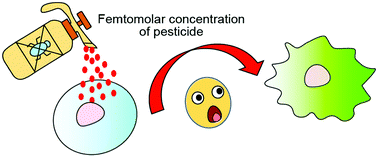An array-based nanosensor for detecting cellular responses in macrophages induced by femtomolar levels of pesticides†
Abstract
Environmental agents can induce cellular responses at concentrations far below the limits of detection for current viability and biomarker-based cell sensing platforms. Hypothesis-free cell sensor platforms can be engineered to maximize sensitivity to phenotypic changes, providing a tool for lowering the threshold for detecting cellular changes. Pesticides are one of the most prevalent sources of chemical exposure due to their use in food and agriculture fields. We report here a FRET-based nanosensor array engineered to maximize responses to changes at cell surfaces after pesticide exposure. This sensor array robustly detected macrophage responses to femtomolar concentrations of common pesticides–orders of magnitude lower concentrations than traditional toxicological and biomarker-based strategies. Significantly, this platform was able to classify these responses by pesticide class, demonstrating the ability to distinguish between changes induced by these different agents. Taken together, hypothesis-free cell surface sensing is a promising tool for detecting the effects of ultra-trace environmental chemicals on human health, as well as detecting threshold responses for use in drug discovery and diagnostics.



 Please wait while we load your content...
Please wait while we load your content...